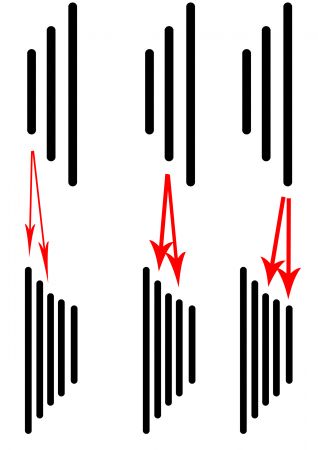Confused by bicycle gears? Here’s how to get your head wrapped around them.
The single most intimidating thing for people new to recumbent trikes is how to use the gears. Most of us have never driven a standard car, let alone figured out why anyone would need 30 speeds on a trike. Hopefully the following will help ease you into shifting so you can ride more easily with less worry.
The purpose of gears is to help you pedal comfortably no matter the terrain. If you had a single speed trike it would feel great riding on the bike path if it is flat. Sometime though you are going to start up a hill. In the car we would just push the gas pedal but on a bike YOU are the motor. We are trying to keep your breathing and heart rate pretty much the same so to do that we shift the gears. Recumbent trikes usually have three chainrings on the front and eight, nine or ten cogs on the rear wheel.
Beginners will do well to leave the front gears in the middle ring and just shift the rear gears. Most days the rear gears are enough to keep you moving along comfortably and not huffing and puffing. Your left hand shifts the gears on the front and your right shifts the back gears. You will shift up or down with your right hand often during the day to keep how hard your body is working roughly the same. You will shift with the left hand only when you have used up the rear gears and wish you had more. Imagine you see a hill just ahead and are thinking, “oh crap, I’m never going to make it up this.” Now’s the time to do some shifting to make it easier to pedal up the hill. First you want to make sure you are in the easiest gear in the back. Often there is an indicator that tells you which gear you are in near your right hand build into the shifter. Once you are sure about that it’s time to shift into the smallest chainring in the front. That will be the easiest gear to pedal up a hill with. It is important to shift into this gear BEFORE you start up the hill. It is hard to get the gears to shift if you are pushing really hard on the pedals so you always want to shift before you think you need to.
On a trike you can go as slowly as you need to take it easy on yourself because you don’t have to keep your balance like on a two wheeled bike. Feeling that you are pedaling too easily at first is OK because once you are on the hill you will be smiling, not frowning from the effort. Once you get to the top of the hill and the pedaling is easy again you should shift the front gears back to the middle using the left shifter. You can see the chain moving when you shift the front gears because the three rings are right there between your feet. If the chain is on the middle ring you did it right. If it’s still on the little ring try again until it moves to the middle. Now you are back to just shifting the gearing at the back with your right hand to keep yourself working at a pace you are comfortable with.
The next thing to master is using the big ring on the front. Its purpose is to help you go faster as you get stronger from riding your trike for a while. Eventually there will come a time when the wind’s at your back or you are riding down a hill and want to go faster than you can pedal. First make sure to shift the rear gears into the hardest to pedal gears with your right shifter. If you still feel like you can do even more then shift the front gears into the largest ring at the front using your left shifter. This will be the hardest but fastest combination on your trike. Keep spinning until it starts getting too hard then shift the right hand gears one at a time until you can maintain your effort without working too hard. Once you are back to flat riding or you are getting tired, shift the front into the middle ring and continue on as usual. Think of the little and largest rings in the front as exceptions to the rule that you use when shifting the back gears just can’t handle the situation you are in.
I hope this helps get you started feeling more comfortable with the gears on your trike. This is not the “Official” way to use gears but it will get you going until shifting becomes automatic and not something you have to think about. There are more efficient ways to use your gears so each jump from one to the next is about the same amount of change but that requires multiple shifts on the front AND rear to work and is a lot to keep track of. My advice is save it for the engineers and just have a good time riding your trike.
Extra Credit Gear Concept To Keep Your Trike Happy
Cross chaining is another gear related thing to be aware of and careful about. Your chain is happiest when it runs in a straight line like a single speed bike. It’s normal and OK to shift from one extreme to the other in the back when the chain is on the middle ring in the front. It twists it sideways a little bit but not enough to wear it out quickly. Cross chaining is when you have the chain on the little ring in the front and the smallest cog in the rear OR the biggest ring in the front and the biggest in the rear.
That’s bad for your trike in a couple ways; the twisting pressure wears the chain and teeth of the gears out much quicker than normal and the rear derailleur is not designed to properly handle that much tightness and looseness . In the big-big combo the chain pulls the derailleur so tight that it is close to breaking. In the little-little the spring in the derailleur can’t wrap up the extra loose chain and it just hangs.
If you think about it cross chaining doesn’t make any sense; you are in the hardest to pedal ring and the easiest to pedal cog or the easiest to pedal ring and the hardest to pedal cog. They just don’t go together and aren’t designed to work that way. What you should have done was shift back into the middle ring in the front when you got to the top of the hill instead of leaving in the smallest ring. Nothing will blow up (probably) if you do it by accident but things will wear out quickly if you left it like that from ignorance. Now you know better and should have a very happy trike.
This Is The Least Harmful Way
 Bicycle Man
Bicycle Man 
